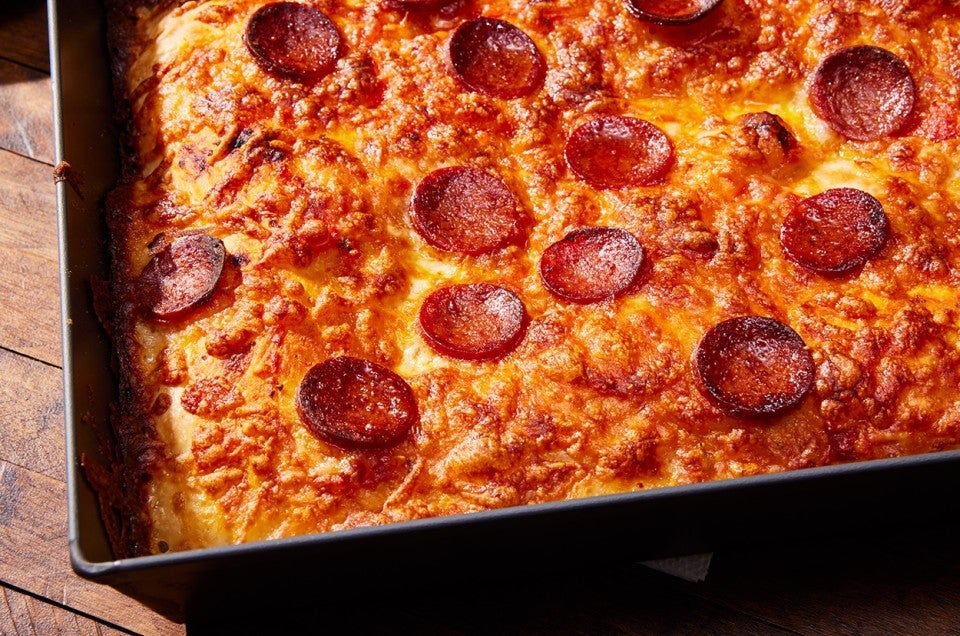


Welcome to Pan Pizza Month. For more pizza inspiration and education, sign up for our Pizza School newsletter where you’ll learn how to make fantastic pizza of all styles.
I resisted buying a Detroit-style pizza pan for a long time. Not because I don’t like the style of pizza for which this pan is intended: I mean, who can resist a rectangular pizza with a thick crust that’s both chewy and crispy, topped with cheese that’s spread all the way to the edges so that it caramelizes against the sides of the high-sided pan?
I resisted, mostly, because I already have a drawer full of bakeware (so full, in fact, that I have to do some heroics — including laying on the ground and pushing with my feet — to get the drawer to close). Eventually, though, I caved. I needed to make this pizza at home. And while I may have bought the pan for pizza, I soon found that’s hardly all it’s good for.
In general, aluminum is a good choice for bakeware because it’s lightweight but conducts heat well. The heavier gauge the pan, the more heavy-duty (and less susceptible to warping) it will be. Beyond pan weight, its color can also impact your baking. Typically, we recommend using a lighter-colored aluminum pan if you’re baking a cake or something else that you don’t want to brown significantly, because a dark metal pan absorbs and distributes heat more quickly and thoroughly than a lighter-colored pan. But if you dream of browned, crunchy crusts and edges, a darker, heavier gauge pan will help you realize that dream.
The Detroit-style pizza pan, manufactured in Washington state by LloydPans, is nearly black in color, thanks to the process of anodization — in which the pan is subjected to an electrolytic process that involves immersing the pan in a chemical bath and then applying an electric current to it — causing a layer of oxide to be produced. The oxide hardens on the pan, leaving it with a dark, extremely durable, nonreactive, rust and stick-resistant coating.

This is particularly handy when you’re making a Detroit-style pie, as one of the hallmarks of this style is an extremely generous amount of cheese that’s spread edge to edge, baking into a lovely, lacy, cheesy border. If you were to bake this pizza in a standard uncoated aluminum pan, the odds of getting that characteristic frico would be slim, and the probability of it sticking? High. But baked in an anodized pan? Look ma, no sticking! What’s more, the edge and bottom of your pizza will be beautifully browned. And because the pan is made of heavier gauge aluminum, it resists warping, even when you’re baking something at high heat, like this White Pizza with Garlicky Broccoli Rabe or Taiwanese Bakery Sourdough Focaccia (the company says the pan and coating are heat safe to 700°F).
I’d expect a pan that was specially designed for pizza to make good pizza. But I couldn’t justify the purchase of a pan that was only good for pizza.
If you love crunchy edges, the Detroit-style pizza pan will quickly earn its keep. I used the pan for a batch of loaded blondies, expecting that the pan’s dark coating might enhance their browning. The pan delivered: My blondies browned magnificently all over, with a deep golden band at the edges. That browning translated to flavor (lots of toasty, roasty notes) and texture (crunch!). The same was true for shortbread, which developed an irresistibly nutty brown butter flavor where the dough met the pan’s edges.

Beyond pizza and buttery cookies, the pan also makes good cornbread better: I preheated it with a film of bacon fat before pouring in a double batch of batter and the resultant cornbread had the crunch I associate with cornbread baked in a cast iron skillet. And I can’t wait to use the pan for my next batch of granola bars.
Admittedly, this pan can’t do it all. If you are a fan of soft, gooey bakes (or are making a recipe, like a cake, where a soft, tender texture is key), the Detroit-style pizza pan isn’t the bakeware I’d suggest choosing. Because of its excellent conductivity and dark pan coating, it can’t help but brown things, especially if those things contain sugar, which caramelizes the more it’s exposed to heat.
But if you’re a fan of crusts, a devotee of toasty edges, and a lover of crunch — or even if you only ever use the pan for a crispy Pick-Your-Pan Pizza, golden pretzel focaccia, or a fully-loaded Taiwanese Bakery Sourdough Focaccia, it’s a workhorse of a pan that earns its keep.
From Bundts to half-sheets (and more!), browse our collection of pans.
Cover photography (Pick-Your-Pan Pizza) by Rick Holbrook; food styling by Kaitlyn Wayne.


